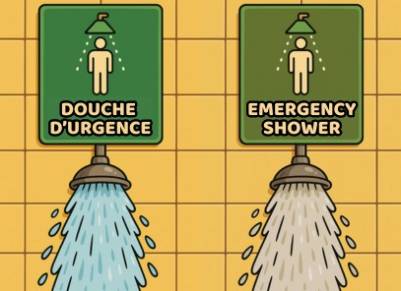
In industrial buildings, laboratories, hospitals and schools, emergency showers are among the mandatory safety installations. They allow for immediate rinsing of a person who has been exposed to hazardous chemical or biological products; their presence is essential.
But what happens when these showers are never used? All too often, these showers remain inactive for long periods, leading to a more or less well-known phenomenon: water stagnation in the pipes.
And, of course, this stagnation is not without consequences!
Does having an emergency shower installed give you the impression that you would be ready to deal with any workplace accidents? However, poorly maintained equipment can very well aggravate your situation instead of correcting it! Indeed, when water is not circulating, it loses its quality. Little by little, an environment favorable to the growth of certain bacteria emerges.
Among the most worrying are: Legionella pneumophila, which causes legionellosis. This serious lung infection can be caught by inhaling tiny drops of contaminated water. It thrives particularly well between 32°C and 45°C, a common temperature range in inactive pipes¹.
According to the Institut national de santé publique du Québec (INSPQ), between 2016 and 2020, Quebec recorded between 117 and 224 cases of legionellosis per year, with an annual average of 174 cases. Also, the observed mortality rate varies between 3.1% and 6.6%, representing a total of 37 deaths over five years². In addition, in 2021, an outbreak in Montreal also led to two deaths, according to Public Health³.
Added to this are the formation of biofilms, corrosion of materials, deterioration of seals, not to mention unpleasant odours. So, stagnant water is not just a technicality: it is an alarming health risk⁴!
Emergency showers must be functional at all times, even when not in use. Several standards govern their maintenance. For example, ANSI Z358.1-2014, is widely used as a reference in Canada, requires weekly testing of emergency showers, as well as a complete annual inspection by a certified professional⁵ . Also, the Quebec Construction Code - Chapter III (RBQ) specifies that any device connected to drinking water must be maintained in good working order and comply with current health and safety requirements⁶ .
Therefore, in order to comply with these standards and prevent non-compliance, it is essential to implement a few simple best practices, such as running each shower at least once a week for 3 to 5 minutes, manually checking the flow rate and temperature, and identifying dead or rarely used pipes⁷.
As you can see, a few minutes of weekly maintenance is all it takes to maintain compliance... and ensure your safety!
1. Gouvernement of Quebec. (n.d.). Legionellosis. Legionellosis | Gouvernement du Québec
2. Institut national de santé publique du Québec (INSPQ). (2022). Rapport de surveillance de la légionellose 2022 (p. 6).
3. La Presse. (2021, 4 août). La légionellose fait deux morts à Montréal.
4. Darspec. (2022). Guide de réouverture des bâtiments – Eau stagnante et gestion du risque.
5. American National Standards Institute. (2014). ANSI Z358.1-2014: Emergency eyewash and shower equipment. https://webstore.ansi.org/Standards/ISEA/ANSIZ3582014
6. Régie du bâtiment du Québec (RBQ). (n.d.). Code de construction du Québec, Chapitre III – Plomberie. https://www.rbq.gouv.qc.ca
7. Boudrias, S. (2018). L’eau stagnante : un danger encore méconnu. Source, 14(1), Darspec.
We use cookies
Respecting your privacy matters to us. We use cookies to personalize our content and facilitate your digital experience. Some cookies may be collected with your consent.
Essential
Essential cookies help make a website usable by enabling basic functions such as page navigation and access to secure areas of the website. The website cannot function properly without these cookies.
Performance
These cookies enable us to analyze navigation on our sites and improve their operation.
Customization
Preference cookies enable a website to remember information that modifies the behavior or appearance of the site, such as your preferred language or the region you are in.
Targeted advertising
These cookies help us limit the number of times you see an advertisement, personalize our offers and services according to your centers of interest, measure the effectiveness of an advertising campaign, and so on. They may be shared with our partners.
We use cookies
Respecting your privacy matters to us. We use cookies to personalize our content and facilitate your digital experience. Some cookies may be collected with your consent.
